Fistfights on the House Floor
In January 1913, 110 years ago this month, old and new political animosities in Wyoming’s House of Representatives exploded into an actual fistfight. Blows were swapped, chairs were thrown and glass was broken when, reportedly, a framed picture was smashed over the head of a lawmaker. At issue was a crucial question—who was the rightful speaker of the House?

It began when the elected speaker left the chair at a tense moment to join the debate. When he tried to regain it, the speaker pro tempore (the temporary speaker) refused to give up the gavel. The elected speaker dragged the speaker pro tem and his chair from the dais, the chair fell on top of the speaker pro tem—and that’s when the fighting really began.
We recalled these events last week when the U.S. House of Representatives took 15 ballots and more than four days to elect Rep. Kevin McCarthy of California to the speaker’s chair. No punches were thrown, thank goodness, though late on Friday Jan. 6, after the 14th ballot, it looked briefly like things might get physical.
In Wyoming in 1913, the chamber was even more evenly divided between Democrats and Republicans than the U.S. House is now, with its four-seat Republican majority. There were 29 Republicans and 28 Democrats in Wyoming’s House. Then Martin Luther Pratt, a previously unknown freshman Republican from Powell, decided he would switch parties and join the Democrats—and run for speaker. He won, with the Democrats assuming that would give them the majority.
The stakes were sky high. Legislatures, not the voters, still elected U.S. senators back then. Longtime Republican Sen. F.E. Warren was up for reelection to a fourth full term. But the Republican party itself was deeply divided in the nation and the state. The previous year former President Theodore Roosevelt had left the Republicans and formed the Progressive, or Bull Moose Party to run for a third term. That had split the Republican vote nationwide and resulted in the election, with less than half the popular vote, of Democrat Woodrow Wilson as president.
In Wyoming, Warren’s old enemy, Joseph Carey, who had served briefly as a Republican in the U.S. Senate in the 1890s before Warren and his allies drove him off, had switched parties and run successfully as a Democrat for governor in 1910. Now, Carey had allied himself and his influence not just with Democrats but with Progressive members of the Republican camp too—and it looked very much like the Warren machine, as it was known statewide, might end up out in the cold.
There’s lots more to the story, including some disputed elections in Lincoln County and general distrust and division all around. By contrast, Wyoming’s House as it begins the 69th Legislature, is about as heavily Republican as it’s ever been—with 57 Republicans and five Democrats. But that majority, mirroring divisions on the national level, is deeply split between moderates and the hard right. So we’ll all do well to pay close attention this week as the Legislature starts another session. We wish all the lawmakers the best, so they can get difficult things done to serve the people who put them there. And now and then we might glance back to 1913, for a reminder of how bad things can get.
- Read Gregory Nickerson’s excellent article, Riot at the 12th Wyoming Legislature: Fisticuffs on the House Floor
